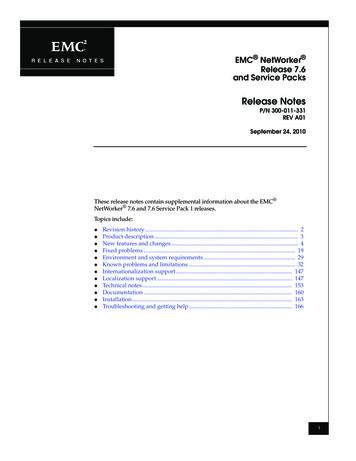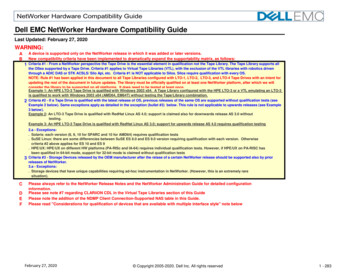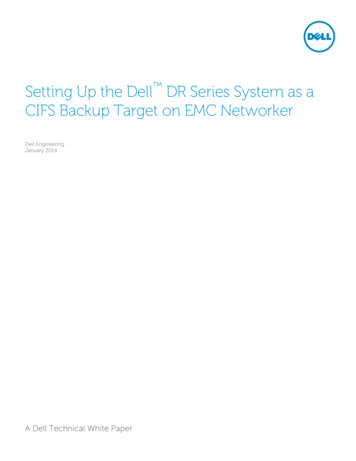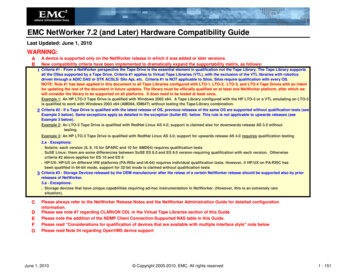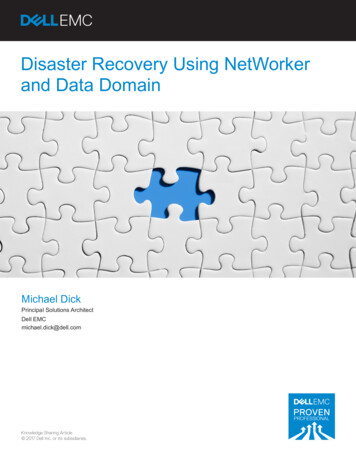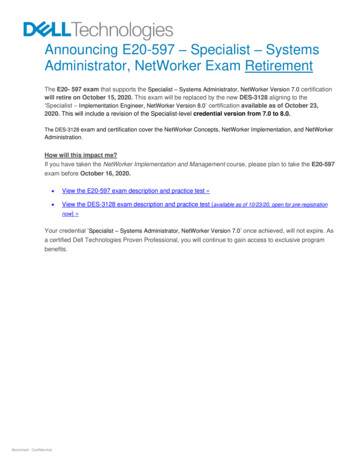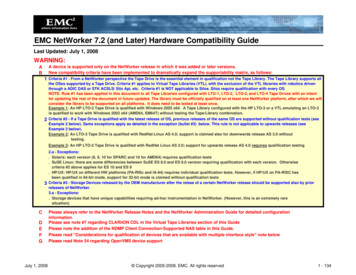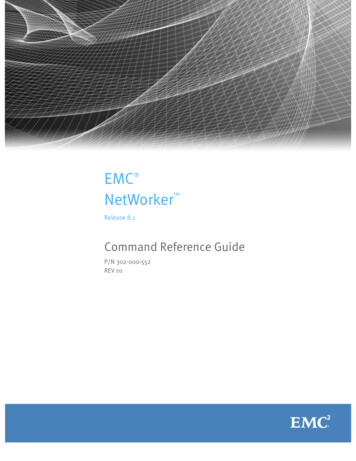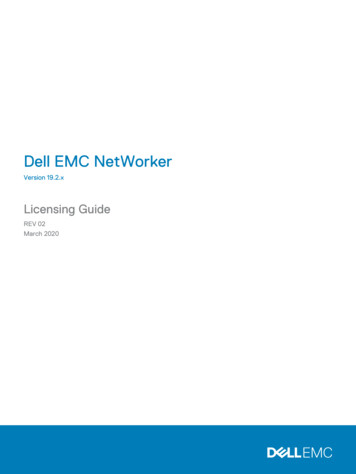
Transcription
MMINFO(1m)NetWorker command:MMINFO(1m)NAMEmminfo - NetWorker media database reporting commandSYNOPSISmminfo [ -avV ] [ -o order ] [ -s server ] [ -x exportspec ][ report ][ query ] [ volname. ] report : [ -m -p -B -S -X -r reportspec ] query : [ -c client ] [ -l ] [ -N name ] [ -t time ][ -q queryspec ]DESCRIPTIONThe mminfo command reports information about NetWorker media and save sets. The mminfocommand can produce several different reports depending on the flags specified. Severalbuilt-in reports can be specified using shorthand flags. Custom reports can also bespecified. The default report, along with the built-in reports printed by the use ofthe -v, -V, -m, -p, -S, -B, and -X flags, are described first below. The custom queryand report generators, using the -q queryspec and -r reportspec options, are describedin the CUSTOM QUERIES AND REPORTS section. Other options are described in the OPTIONSsection.Without any options, mminfo displays information about the save sets that completedproperly since the previous day’s midnight, and are still contained in an online fileindex (browsable save sets). The following information is printed for each save set:the containing volume name, the client’s name, the creation date, the size saved onthat volume, the save set level, and the save set name. The size field is displayed inbytes (B), kilobytes (KB), megabytes (MB), gigabytes (GB), terabytes (TB), petabytes(PB), or exabytes (EB). The save set level will display ‘full’, ‘incr’, ‘migration’ or1 through 9, for full, incremental, migration save sets, level 1 through 9, respectively. The level is only kept for scheduled saves and file migration; save sets generated by explicitly running the save(1m) command (called ad hoc saves) do not have anassociated level.Specifying the -v flag prints aborted, purged, incomplete and recoverable save sets inaddition to the complete, browsable save sets printed by default. The -v flag alsocauses three additional fields to be displayed: the creation time, the internal saveset identifier (ssid), and two flags. One character is used per flag.The first flag indicates which part of the save set is on the volume. When the save iscompletely contained on the volume, a c is displayed. An h is displayed when the saveset spans volumes and the head is contained on this volume.The remaining sections will be on other volumes. An m is displayed when the save setspans volumes and a middle section is contained on this volume. The head and tail sections will be on different volumes. There may be more than one middle section. A t isdisplayed when the tail section of a spanning save set is contained on this volume.Again, the other sections will be on other volumes.The second flag indicates the status of the save set. A b indicates that the save setis in the online index and is browsable via the recover(1m) command. An r indicatesthat the save set is not in the online index and is recoverable via the scanner(1m) command. An E indicates that the save set has been marked eligible for recycling and maybe overwritten at any time. An a indicates that the save was aborted before completion.Aborted save sets are removed from the online file index by nsrck(1m). An i indicatesthat the save is still in progress.EMC NetWorker 7.4 Serice Pack 1 Command Reference Guide1
MMINFO(1m)An optional third flag indicates the type of save set. An N indicates an NDMP save set.An R indicates a raw partition backup, eg., Networker Modules like Oracle, Sybase andothers that Networker supports. It does not denote the save set contains files utilizing the rawasm directive. A P indicates a snapshot save set.An optional fourth flag s indicates whether an NDMP save set was backed up viansrdsa save to a NetWorker storage node.The -V flag displays even more detail than the -v flag. This format also displaysinformation such as, media file number and record number that can be used to speed theoperation of the scanner(1m) command. The -v flag displays one line per save set pervolume. The -V flag displays three lines for each section of a save set occuring withina file on a volume. A single save set will have multiple index entries if it starts inone file on a volume and ends in another. This report contains all of the informationreported via the -v flag, but, because of the additional detail, some of this information is reordered. The first line will contain the volume name, the client’s name, thesize saved in that section, the save set level, and the save set name. The size fieldlists the number of bytes that are contained in the section, rather than the totalamount of the save set on this volume. The second line contains the following fields:the internal save set identifier (ssid), the save time in seconds since 00:00:00 GMT,Jan 1, 1970, the creation data and time of day, the internal save set identifier(ssid), the save set browse time, and the clone instance retention time. The thirdline contains: the offset of the first and last bytes of the save set contained withinsection, the media file number, the first record within the media file containing datafor this save set, the internal volume identifier (volid), the total size of the saveset, and the flags, described in the -v paragraph above, indicating which part of thesave set is contained in this media file (c, h, m, or t) and the save set’s status (b,r, a, or i).The -p flag causes mminfo to display a report on the browse and retention times for savesets. Each line of the report displays the save set creation date, and the storedbrowse and retention dates (‘undef’ is displayed when connecting to a downrev server),the save set identifier, the client’s name, and the save set’s name. The -v and -Voptions have no effect on the columns included in this report.The -m flag causes mminfo to display the name of each volume in the media database, thenumber of bytes written to it, the percent of space used (or the word ‘full’ indicatingthat the volume is filled to capacity), the retention (expiration) time, the number ofbytes read, the number of times the read-label operation has been performed on the volume (not the count of explicit mounts), and the volume’s capacity. Volumes that arerecyclable (see nsrim(1m)) are flagged by an E in the first column (meaning Eligiblefor recycling). If a volume has been marked as manuallyrecyclable, an M is displayedinstead of the E. If a volume is both manually-recyclable and eligible for recycling,an X will be displayed. Archive and migration volumes are flagged by an A, also in thefirst column. If the volume is not an archive or migration volume, and is not recyclable, no flag appears.Specifying the -v flag with the -m flag causes three additional fields to be displayed:the internal volume identifier (volid), the number of the next file to be written, andthe type of media.Using a -V flag with the -m adds a column of flags to the output. There are currentlytwo possible flags. The d flag is set if the volume is currently being written (dirty).The r flag is set if the volume is marked as read-only. If neither condition ispresent, the flags column will be empty.The -S flag displays a long, multiline save set report, which is used for debugging.The number of lines varies per save set. Due to the length, there are no column headers.Instead, each attribute of the save set is displayed in a ‘name value’ manner, except2EMC NetWorker 7.4 Serice Pack 1 Command Reference Guide
MMINFO(1m)the client and save set name, which are displayed as ‘client:name’, and the extendedattributes, described below. The first line of each multiline group starts on theleft margin and includes the save set identifier (ssid), save time as both a date/timestring and seconds since 00:00:00 GMT, Jan 1, 1970, and the client and save set names.Subsequent lines for this save set are indented. If the save set is part of a save setseries (a ‘continued save set’) and is not the first in the series, the save set identifier of the previous save set in the series in shown on the second line by itself. Thenext line displays the level, the save set flags (in ‘ssflags’ format, as described inthe table in the CUSTOM QUERIES AND REPORTS section), the save set size in bytes, thenumber of files in the save set, and the save set insertion date. The next line displaysthe save set’s create, completion, browse and retention (expiration) dates. The string‘undef’ for any of the values on these two lines generally means an older server thatdoes not store these values is being queried. If the client identifier is set, it isprinted on the next line. If the save set has extended attributes (such as the group towhich the save set was a part or the archive annotation), they are printed next, at mostone attribute per line. The format of each extended attribute is "name: values;". Theclones or instances of the save set are shown last (every save set has at least onceinstance). The first line of each clone shown the clone identifier, the date and timethe instance was created, the clone retention date, and the per-clone flags (in‘clflags’ format from the CUSTOM QUERIES AND REPORTS table). For each instance, eachsection of that instance is shown as a fragment line. The fragment line shows the offset of that fragment from the beginning of the save set, the volume identifier (volid)containing the fragment, the media file and record numbers of start of the fragment, anabsolute positioning identifier (unused by existing servers), and the date of lastaccess of the fragment. The -v and -V options have no effect on this report. The -osort order options o and m are ignored when -S is specified.The -X flag prepares a save set summary report instead of one or more lines per saveset. Note that the entire media database must be examined to resolve this query, makingit very slow and expensive. If used in conjunction with the a option, the query of allvolumes is done to check for save sets. If used without the a option, only save setinformation in the last 24 hours, is considered. The summary lists the total number ofsave sets, and breaks the total down into several overlapping categories summarizingthe save set types. The recent save set usage, if appropriate to the query, is alsoprinted. The categories are the number of fulls, the number of incrementals, the number of other non-full, non-incremental saves, the number of ad hoc, archive, migration,empty and purged save sets, the number of index save sets, and finally, the number ofincomplete save sets. For recent usage, the number of save sets per day is shown, up toa week ago, along with a summary of the week’s save sets and, if applicable, a summaryof the month’s save sets. For each line, the number of files (saved in the time intervalspecified), number of save sets, total size, average size per save set, and averagesize per file are listed. The percentage of the amount saved for incrementals versusfulls and the percentage of browsable files are also printed, when appropriate. The-v and -V options have no effect on the summary report.The -B flag performs a canned query to output, in a convenient format, the list of bootstraps generated in the previous five weeks. In this format, there is one line of output for each matched save set. Each line contains the save date and time, save level,save set identifier (ssid), starting file number, starting record number, and the volume. The equivalent query is described below in the EXAMPLES section. The -v and -Voptions have no effect on the bootstrap display.OPTIONS-aCauses queries to apply to all complete, browsable save sets, not just those inthe last 24 hours. This option is implied by the -c, -N, -q, -m, and -ooptions, described below. When combined with a media-only report (-m or acustom report showing only media information), -a applies to all volumes, notjust those with complete and browsable save sets.EMC NetWorker 7.4 Serice Pack 1 Command Reference Guide3
MMINFO(1m)-c clientRestricts the reported information to the media and/or save sets pertaining tothe specified client. This is similar to specifying a client name using thequeryspec (see -q option) name. In both cases the names are matched using acase insensitive string comparsion. If the reportspec (see -r option) includesvolume, the reported information will include those pertaining to the aliasesof the client. If information relating to the aliases of the client is notrequired in the output, when the reportspec includes volume, the -l optionneeds to be used in conjunction with -c client.-lThis option when used with -c client along with reportspec (see -r option)containing volume, the output will not include all the information pertainingto the aliases of the specific client.-mDisplays a media report instead of the default save set report (in other words,a report about the media containing save sets, not the save sets themselves).-N nameRestricts the reported information to the media and/or save sets pertaining tothe specified save set name.-o orderSorts the output in the specified order. Before displaying the save sets, theyare sorted by various fields. Numeric fields are sorted least to greatest,other fields are sorted alphabetically. order may be any combination of theletters celmnotR, representing client, expiration date, length, media name,name of save set, offset on media (file and record number), time, and Reverse,respectively. The default sorting order for save set reports is mocntl. Theoffset fields (file and record) are only considered when the -V option has beenselected and for custom reports that show save set section (fragment)information. When applied to -m media-only reports, the length is the amountused on the volume, the time is the last time the media was accessed, and theother order flags are ignored.-pDisplays a report on the browse and retention times for save sets, describedabove.-q queryspecAdds the given query constraint to the list of constraints on the currentquery. Multiple -q options may be given. See the CUSTOM QUERIES AND REPORTSsection below for the syntax of the queryspec.-r reportspecAppends the given report specification to the list of attributes to bedisplayed for the current query. Multiple -r options may be given. See theCUSTOM QUERIES AND REPORTS section below for the syntax of the reportspec.-s serverDisplays volume and save set information from the NetWorker system on server.See nsr(1m) for a description of server selection. The default is the currentsystem.-t timeRestricts the reported information to the media and/or save sets pertaining tothe save sets created on or after time. See nsr getdate(3) for a description ofthe recognized time formats. The default is ‘yesterday’, except when usingthe following switches: -a, -B, -c, -N, -m, -o and -q. When using thoseswitches, there is no default value for time. If you wish to see only thebackups since yesterday, you will have to specify ‘-t yesterday’ explicitly.4EMC NetWorker 7.4 Serice Pack 1 Command Reference Guide
MMINFO(1m)-vTurns on the verbose display reports, described above.-x exportspecAs an alternative to the default human-readable output format, exportspecprovides for two styles of programreadable output formats. The exportspec ‘m’displays XML output, while exportspec ‘c separator ’ displays values separatedby any single character or string. For example, ‘mminfo -xc,’ will producecomma-separated values.-BRuns the canned query to report bootstraps which have been generated in thepast five weeks, as described above. This option is used by savegrp(1m) whensaving the server’s index and bootstrap.-SDisplays a long, multiline save set-VDisplays additional verbose report output, as described above.-XPrepares a summary report, as described above.report,as described above.CUSTOM QUERIES AND REPORTSThe custom query and report options of mminfo allow one to generate media and save setreports matching complex constraints without resorting to pipelines and scripts. Thissection describes the syntax of custom query and report specifications, and gives somesimple examples. Further examples are shown in the EXAMPLES section, below.The custom query option, -q queryspec, is an extension to the shorthand query options,such as -c client, which allow you to make queries based on almost any media or save setattribute in the database, and allow various comparisons in addition to the simpleequality comparison provided by the shorthand options. The format of a queryspec is[!] name [ comp value ] [ , . ]where name is the name of a database attribute, listed in the table below, comp is avalid comparator for the attribute, from the set ‘ ’, ‘ ’, ‘ ’, ’ ’, ’ ’, and valueis the value being compared. Leading and trailing spaces can be used to separate theindividual components of the specification. The comparator and value must be specifiedfor all but flag attributes. Generally numeric attributes allow all five comparators,and character string attributes generally only allow equality. When comparing flagswhose values are normally ‘true’ and ‘false’, one may alternatively use the ‘[ !] name’ syntax. The ‘!name’ form is equivalent to ‘name false’, and ‘name’ by itself isequivalent to ‘name true’. The comparisons in the specification are separated bycommas. If a time or a string contains commas, you must quote the value with single ordouble quotes. Quotes are escaped within a string by repeating them. The following isa valid string comparison:name "Joe’s daily, ""hot"" Save Set"Note that command line shells also interpret quotes, so you will need to enclose theentire query within quotes, and quote the single value inside the query, possibly witha different kind of quote, depending on the shell. Except for multiple character-stringvalues, explained below, all of the specified constraints must match a given save setand/or media volume before a line will be printed in the report. Multiple -q optionsmay be specified, and may be combined with the shorthand query constraints -c, -N and t. The order of the above query constraints is unimportant.Numeric constraints, except for identifiers (volume, save set and clone identifiers),allow ranges to be specified, and all character string constraints allow multiple possible values to be specified. Note that times and levels are considered to be numericvalues, not character strings. The upper and lower bounds of a numeric range are spec-EMC NetWorker 7.4 Serice Pack 1 Command Reference Guide5
MMINFO(1m)ified as two separate constraints. For example,%used 20,%used 80matches volumes that are between 20% and 80% used. All strings are also lists except’attributes and volume attributes’. Each possible value of a given character- stringattribute is specified as a separate equality constraint. For example,client pegasus,client avalonmatches save sets from the client ‘pegasus’ or the client ‘avalon’.Example, if ‘group’ string attribute is used multiple times, the ‘mminfo’ query wouldbemminfo -av -q ‘group Default, group Test’This would report save sets for both ‘Default’ and ‘Test’ groups.The custom report option, -r reportspec, allows one to specify exactly which media andsave set attributes should be shown in the report, the order of the columns, the columnwidths, and where line breaks should be placed. The format of a reportspec isname [ (width) ] [ , name [ (width) ] . ]where name is the name of a database attribute, listed below, and the optional width,enclosed in parentheses, specifies how wide the column should be. Leading and trailingspaces are ignored. The default column width depends on the attribute; default widthsare also shown in the table below. Multiple -r options may be specified. The order ofthe columns in the report will be left to right, and correspond to the order of theattribute names specified. Each line of output will contain all of the data requested(you can cause line breaks within a logical line by using the newline attribute name).If a value does not fit in the requested column width, subsequent values in the linewill be shifted to the right (values are truncated at 256 characters).The table below lists all of the recognized attribute names, their valid range of queryvalues (or ‘NA’ for attributes that are only valid for report specifications), theirdefault column width in characters (or ‘NA’ for flag attributes that are only valid forquery specifications), and a short description.Numeric attributes (shown as number in the valid range column of the table) can bespecified using any of the comparators listed above, and can be used in range comparisons.The id attributes are used for various identifiers (volume identifier, save set identifier, and so on) and only allow equality comparisons. In most cases, if the column isnarrow (less that 50 characters), only the short ID is shown, which correponds to theID used by downrev servers. If the column is wide enough, the full ID is shown. Clientidentifiers always display as full IDs, and clone identifiers always display asshort IDs.Flag attributes have the values ‘true’ or ‘false’, only apply as query constraints, andhave corresponding flag summary strings for report specifications.Time attributes are specified in nsr getdate(3) format and are otherwise treated asnumeric attributes (note that you will need to quote times that contain commas). Thespecial time ‘forever’, when used as an expiration date, means asave set or volume will never expire. The special time ‘undef’ is displayed when thetime is undefined. When output, times are displayed according to local settings, usu-6EMC NetWorker 7.4 Serice Pack 1 Command Reference Guide
MMINFO(1m)ally as MM/DD/YY HH:MM:SS for numeric month, day year (last two digits), hours, minutes, and seconds, respectively for English (United States) locale. If the column isvery narrow (less that 17 characters), only the date is shown. Columns 22 characterswide will generally print the full date. This is dependent on the format reported bythe operating system. If the returned date and time will not fit in the specified columns, only the date is shown.For non-US locales, time attributes are displayed in locale date/time format, whichusually require larger column width specification. If the column width is not bigenough to display the entire locale date/time value for an attribute, locale dateHH:MM (24-hour time) format will be attempted. If the column width is still not bigenough, the date/time column will only display locale date .For example, for certain locales, to display the locale date/time for savetimeattribute, specify an appropriate width, such as:mminfo -avot -r"volume, client, savetime(40), sumsize,level, ssid, name, sumflags"Size and kbsize attributes may havebytes, ‘MB’ for megabytes, ‘GB’ foror ‘EB’ for exabytes. The defaultquery constraints for attributes isbytes. The scale varies in reports,a scale factor appended to them: ‘KB’ for kilogigabytes, ‘TB’ for terabytes, ‘PB’ for petabytes,scale (when no scale is explicitly specified) onbytes; the default for kbsize attributes is kilodepending on the actual value.String attributes may be any arbitrary character string, enclosed in quotes if necessary, as described above in the query syntax olumevolidbarcodefamilytypevolflagsstring mberor ‘full’kbsizenumbernumberwidthdescription1 White space before the next column.1 Line break(s) within a logical line.Width is actually the number ofnewlines desired.15 The volume name.11 The unique volume identifier.15 The volume barcode, when set.4 The media family (for example, tape, disk).7 The media type (for example, 8mm, optical).5 Volume summary flags, d and r,for dirty (in use) and read-only.7NANANANANA1515875855Volume state summary, E, M, X and A,meaning eligible for recycling,manually-recyclable, both, and archiveor migration volumes, respectively.Matches full volumes.Matches in-use (dirty) volumes.Matches recyclable volumes.Matches read-only volumes.Matches manually-recyclable volumes.The pool containing the volume.The volume’s location.The volume’s estimated capacity.Kbytes written to volume.Estimated percentage used, or ‘full’for volumes marked as full.Kbytes read (recovered) from the volume.Next media file for writing.Next media record for writing.EMC NetWorker 7.4 Serice Pack 1 Command Reference Guide7
reatetimessidsnaplevelclient id11flagNA0.9,5full, incr,migrationor manualstring11attrspssidNA idssflagsNAcontinuedflagrecoverable flagssrecycleflag8931117NANANALast time volume was accessed,for read or write, for save or recovertype of operation. A mountoperation will not necessasarily causethe access time to be updated.Old servers do not provide this value reliably.The date the last save set on thisvolume will expire.The first time the volume was labeled.The most recent time the mediavolume was (re)labeled.Number of times the read-label operationis performed on the volume (not the count ofexplicit mounts).Number of times the volumewas relabeled.Summary of volume availability, currentvalid values, n meaning nearline(that is, in a jukebox), and ov meaningthe volume is being managed by SmartMedia.Matches nearline volumes.Matches volumes managed by SmartMedia.Volume speed and desirability metric(unused by existing servers).Number of save sets on a volume.The extended volume attributes.The save set name.The save time (on the client).The save time, printed as secondssince 00:00:00 GMT, Jan 1, 1970.The creation time (on the server).If the client and server clocks are out ofsync, this time may be different from thesave time.The unique save set identifier.Display snapshot backups only.The backup level. Manual backupsare printed as blank columnvalues in reports.The client resource name associated withthe host that was backed up in this save set.The extended save set attributes.When part of a save set series, theprevious save set identifier in theseries, zero for the first or onlysave set in a series.The save set flags summary, one or morecharacters in the set CvrENiRPKIF, forcontinued, valid, purged (recoverable),eligible for recycling, NDMP generated,incomplete, raw(not for savesets backed upusing rawasm), snapshot, cover,in-progress and finished (ended),respectively.Matches continued save sets.Matches recoverable (purged) save sets.Matches recyclable save sets.EMC NetWorker 7.4 Serice Pack 1 Command Reference Guide
me9ssinserttime9115sscomptime9clientid id9copiesnumber6cloneidclonetimeclretent 11995Matches incomplete save sets.Matches rolled-in save sets.Matches NDMP save sets.NAMatches raw save sets, containing partitions saved byNetWorker modules.Matches valid save sets. All save setsare marked ‘valid’ by current servers.Per-volume save set summary flags,as described for the -v report.Per-section save set summary flags,as described for the -V report.The total save set size.The number of the client’s filesin the save set.The save set’s browse time. This isthe time limit that the save set willremain brow
2 EMC NetWorker 7.4 Serice Pack 1 Command Reference Guide MMINFO(1m) An optional third flag indicates the type of save set. An N indicates an NDMP save set. An R indicates a raw partition backup, eg., Networker Modules like Oracle, Sybase and others that Networker supports. It does not denote the save set contains files utiliz-ing the rawasm .
